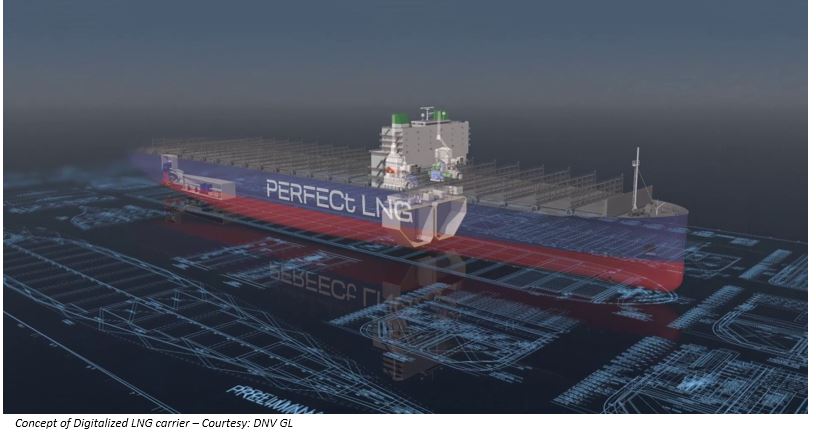

LNG is expected to be the fastest growing fossil fuel until 2030, and digital transformation of the LNG value chain is going to play the key role for this. According to Royal Dutch Shell’s LNG Outlook 2017, the global demand for gas is expected to increase by 2 percent a year between 2015 and 2030 while LNG is set to rise at twice that rate, at 4 to 5 per cent. The recent discoveries, especially in the Middle East and US, will create an oversupply until the demand catches up with production by late 2020s. The oversupply will force providers to further lower their prices and tighten operational margins to ensure that the assets can stay operational until the time of growth in demand. At the same time, more investment is already needed for the industry to be able to meet the increasing global energy demand in the future, accelerating the need to do business differently. The LNG industry is now feeling the urgency to undergo digital transformation to be able to increase productivity and profitability during this time, when spending is low but future dependency on LNG as natural gas is being realized.
One of the core hurdles LNG operators facing to start their digital transformation is the lack of access to an existence of integrated and intelligent facility information. Not having a centralized connected asset creates a challenge for the LNG industry to exchange information and ensure standardization across all disciplines. Digital transformation being the buzz word for the industry, more and more LNG operators are researching ways to get started with the change towards a digital way of working. But, the bad news is that the existing facility information is often not structured or accurate enough to support the first steps of this transformation. The best recommended approach to start setting-up the digital transformation is to capture the inter-connected “as it is” state of a facility, the “digital twin”. Having this up-to-date and easily accessible asset information will provide the basis for a successful digital transformation.

Creating the “Digital Twin” has to start from a document-centric approach to having a data-centric environment for asset information. A data-centric environment allows users to find what they want by starting with what they know. For example, well structured data will ensure real-time operational as well as predictive analysis of the performance matrix of the value chain.
Creating this digital twin includes having all data and documentation in a centralized location that becomes a representation of the physical asset in a digital format. If needed, this can also include capturing of the as-built information of the asset with laser-scanning technology. The first steps towards being able to undergo a real digital transformation can be taken by digitalizing the already existing data and information.
LNG Owner Operators typically have CMMS/ERP systems, DCS/data historians, Asset Performance Management and many other systems within their IT system landscape. These systems and others need information about the equipment and facility configuration that is held in the digital twin, but processes today often involve manually updating these systems or semi-automated data export/import routines that are prone to error. The result is that the master data held in these systems rapidly erode over time and lead to equipment being improperly maintained or even not being maintained at all; incorrect purchase of replacement equipment or parts; and incorrect decisions being taken daily. These all result in cumulative inefficiencies, unnecessary costs and increased risk. Hexagon PPM has implemented ODATA RESTful web services and ready-made integrations to facilitate the exchange of information with third party systems.
Data and documents gathered from multiple sources can be consolidated into a single, cohesive digital twin. They can be subject to validation and verification to identify missing, incorrect, and inconsistent information. Hexagon PPM has well proven technologies to validate data at high speed against a wide range of business rules and class libraries. When combined with extended reality technologies, such as virtual and augmented reality, zero footprint applications provide LNG operators an unprecedented access to real-time data of their facilities. This data can also be leveraged through electronic workflows to transform many bureaucratic, paper intensive manual processes and achieve faster, better and more consistent work processes, such as management of change, review of project deliverables, permit to work, and many more with full auditable traceability.
The first step towards digital transformation for the LNG industry can be taken by digitalizing existing asset information and creating a digital twin of the existing facility. The creation, access, and maintenance of the digital twin via a zero-footprint web client is a major step forward for the LNG industry, but unlocking the value of the digital twin is dependent on being able to exchange this information with other operations systems.
ARC welcomes the opportunity to speak with technology suppliers and users alike about your activities, thoughts, perspectives and questions on this exciting area. For further discussion or to provide feedback on this, please contact the author Jyoti Prakash at jprakash@arcweb.com.
Keywords: LNG, Digital Transformation, Industrial Internet of Things (IIoT), Digital Twin, ARC Advisory Group.

